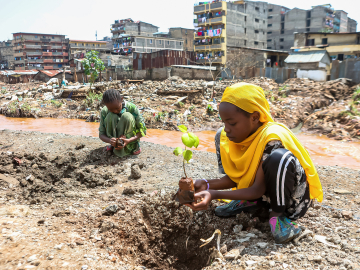Five Reasons Why the Global Health Community Should Help Save Forests
Iceland-sized tracts of forest have disappeared every year since the UN General Assembly proclaimed March 21, 2012, as the first annual International Day of Forests.
It’s time the global health community made protecting forests a priority, on par with combating other urgent threats like climate change and air pollution.
Why? Dollar for dollar, investing in forest conservation can be highly cost-effective due to the many ways it can benefit health, especially for some of the world’s most vulnerable populations.
More than one billion people in LMICs, according to the UNFAO, lived within one kilometer of a forest in 2019. For many of them, forests function as a local supermarket, pharmacy, hardware store, and utility company, providing wild foods, clean water, building materials, fuel wood, and natural medicines.
Deforestation at current scales threatens these benefits—and consequently, the health of these vulnerable communities.
Here are five reasons the global health community should champion forest conservation:
1. Forests feed people.
The diets of the rural poor in LMICs often consist largely of calorie-rich but nutrient-poor staples like maize and rice. Consuming nutritious forest foods like fruits, vegetables, mushrooms, nuts, and seeds improves their diets. A 2018 study published in Science Advances involving approximately 43,000 households in 27 developing countries found that children living within 3 kilometers of forests had 25% higher dietary diversity compared with those who lived farther away.
2. Forests supply clean water.
Research from diverse settings like Brazil, Malawi, and Colombia has found that forests increase water quality and availability by filtering out harmful pollutants, recharging underground aquifers, and preventing soil erosion into streams, rivers, and lakes—all of which can benefit health. A 2017 study in Nature Communications involving almost 300,000 rural children from 35 developing countries found that denser tree cover in upstream watersheds was associated with a lower probability of diarrheal disease among children in downstream communities.
3. Forests provide income sources and strengthen household resilience.
The rural poor are highly vulnerable to stressors such as family illness, crop failure, and rising food prices that can wipe out their assets. Forests provide goods like fuel wood, wild foods, and medicinal plants that can be harvested for household use and sale. Forests can serve as a safety net and increase household resilience by providing alternate sources of food and income, according to a 2019 UN FAO report.
4. Forests prevent and help treat diseases.
In tropical countries, conserving forests can decrease zoonotic disease spillover by reducing interactions between humans and wildlife, and is far less expensive that treating pandemics. Conversely, deforestation brings people closer to wildlife, facilitating pathogen transmission from animals to people. Additionally, the WHO estimates that 80% of people worldwide use traditional medicine, including medicinal plants derived from forests. Deforestation can deprive communities of these important treatments for common conditions like childhood diarrhea.
5. Forests benefit mental well-being.
Research from wealthier countries has shown that spending time in forests has positive impacts on mental health. While mental health is generally understudied in LMICs, forests likely have similar benefits for the rural poor. And for millions of Indigenous people from the Amazon to the Congo Basin, forests are integral to their cultural identity.
---
A Promising Approach
So how do global health organizations get started saving forests? One promising approach is to work closely with local communities to understand why they engage in deforestation and jointly find solutions.
This strategy has been championed by Health in Harmony, a nonprofit founded in 2006 to help save Borneo’s forests. Through radical listening (a method focused on listening to communities and investing in their solutions to problems), Health in Harmony learned that local communities were cutting down forests to generate cash to cover health care expenses. The organization established high-quality, low-cost clinics while working with communities to curtail deforestation.
Over 10 years, Health in Harmony provided health care for over 28,000 people and deforestation decreased by 70% in project areas compared with control areas. The nonprofit has recently brought the radical listening approach to help save forests and improve health in Madagascar and Brazil.
As Nina Finley, who oversees the organization’s research collaborations observed, “Listening to people who live in forests protects forests.”
It can also ensure that forests continue to benefit the health of future generations.
Anila Jacob, MD, MPH, is a physician and food security and global health specialist who works in international development.
Join the 50,000+ subscribers in 170+ countries who rely on Global Health NOW summaries and exclusive articles for the latest public health news. Sign up for our free weekday newsletter, and please share with friends and colleagues.
Forests serve as a supermarket, pharmacy, hardware store, and utility company for millions of people worldwide. kazuend/unsplash.com





